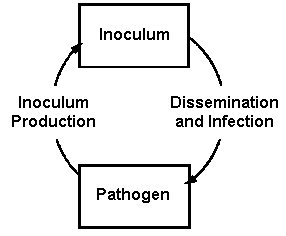
PATHOGEN FACTORS THAT AFFECT DEVELOPMENT OF EPIDEMICS
Levels of Virulence
Virulent pathogens capable of infecting the host rapidly ensure a faster production of larger amounts of inoculum, and, thereby, disease, than pathogens of lesser virulence.
Quantity of Inoculum near Hosts
The greater the number of pathogen propagules (bacteria, fungal spores and sclerotia, nematode eggs, virus infected plants, etc.) within or near fields of host plants, the more inoculum reaches the hosts and at an earlier time, thereby increasing the chances of an epidemic greatly.
Type of Reproduction of the Pathogen
All pathogens produce many offspring. Some of them, such as most fungi, bacteria, and viruses, produce a great many offspring, while a few fungi, all nematodes, and all parasitic plants produce relatively small numbers of offspring. Some plant pathogenic fungi, bacteria, and viruses have short reproduction cycles and therefore are polycyclic, i.e., they can produce many generations in a single growing season. Polycyclic pathogens include fungi that cause rusts, mildews, and leaf spots and are responsible for most of the sudden, catastrophic plant disease epidemics in the world. Some soil fungi, such as Fusarium and Verticillium, and most nematodes usually have one to a few (up to four) reproductive cycles per growing season. For these latter pathogens, the smaller number of offspring and, especially, the conditions of their dispersal limit their potential to cause sudden and widespread epidemics in a single season. Nevertheless, they often cause localized, slower developing epidemics. Several pathogens, such as the smuts and several short-cycle rusts, require an entire year to complete a life cycle (monocyclic pathogens) and can therefore cause only one series of infections per year. In such monocyclic diseases, the inoculum builds up from one year to the next, and the epidemic is usually polyetic, i.e., it develops over several years. Similarly, epidemics caused by pathogens that require more than a year to complete a reproductive cycle are slow to develop.
Examples are cedar-apple rust (2 years), white pine blister rust (3–6 years), and dwarf mistletoe (5–6 years). As a result of overlapping of the polyetic generations, however, even such pathogens each year produce more inoculum and cause a series of infections that lead to long-term epidemics.
Ecology of the Pathogen
Some pathogens, such as most fungi and all parasitic higher plants, produce their inoculum (spores and seeds, respectively) on the surface of the aerial parts of the host. From there, spores and seeds can be dispersed with ease over a range of distances and can cause widespread epidemics. Other pathogens, such as vascular fungi and bacteria, mollicutes, viruses, and protozoa, reproduce inside the plant. In this case, spread of the pathogen is rare or impossible without the help of vectors. Therefore, such pathogens can cause epidemics only when vectors are plentiful and active. Still other pathogens, such as soilborne fungi, bacteria, and nematodes, produce their inoculum on infected plant parts in the soil, within which the inoculum disperses slowly and presents little danger for sudden or widespread epidemics.
Mode of Spread of the Pathogen
The spores of many plant pathogenic fungi, such as those causing rusts, mildews, and leaf spots, are released into the air and can be dispersed by air breezes or strong winds over distances varying from a few centimeters up to several kilometers. These kinds of fungi are responsible for the most frequent and most widespread epidemics.
In terms of their ability to cause sudden and widespread epidemics, the next most important group of pathogens includes those whose inoculum is carried by airborne vectors. Many of the viruses are transmitted by aphids, whiteflies, and some other insects. Mollicutes and fastidious bacteria are transmitted by leafhoppers, plant hoppers, or psyllids. Some fungi (such as the cause of Dutch elm disease), bacteria (such as the cause of bacterial wilt of cucurbits), and even nematodes (such as the cause of pine wilt disease) are disseminated primarily by beetles. Pathogens that are transmitted by windblown rain (primarily fungi causing diseases such as anthracnoses and apple scab, and most bacteria) are almost annually responsible for severe but somewhat localized epidemics within a field, a country, or a valley.
Pathogens carried with the seed or other vegetative propagative organs (such as tubers or bulbs) are often placed in the midst of susceptible plants, but their ability to cause epidemics depends on the effectiveness of their subsequent transmission to new plants. Finally, pathogens present in and spreading through the soil, because of the physical restrictions imposed by the soil, are generally unable to cause sudden or widespread epidemics but often cause local, slow-spreading diseases of considerable severity. When such primarily soil fungi, however, also produce wind-disseminated spores, the latter can spread considerable distances and can cause epidemics destructive over considerable areas.


